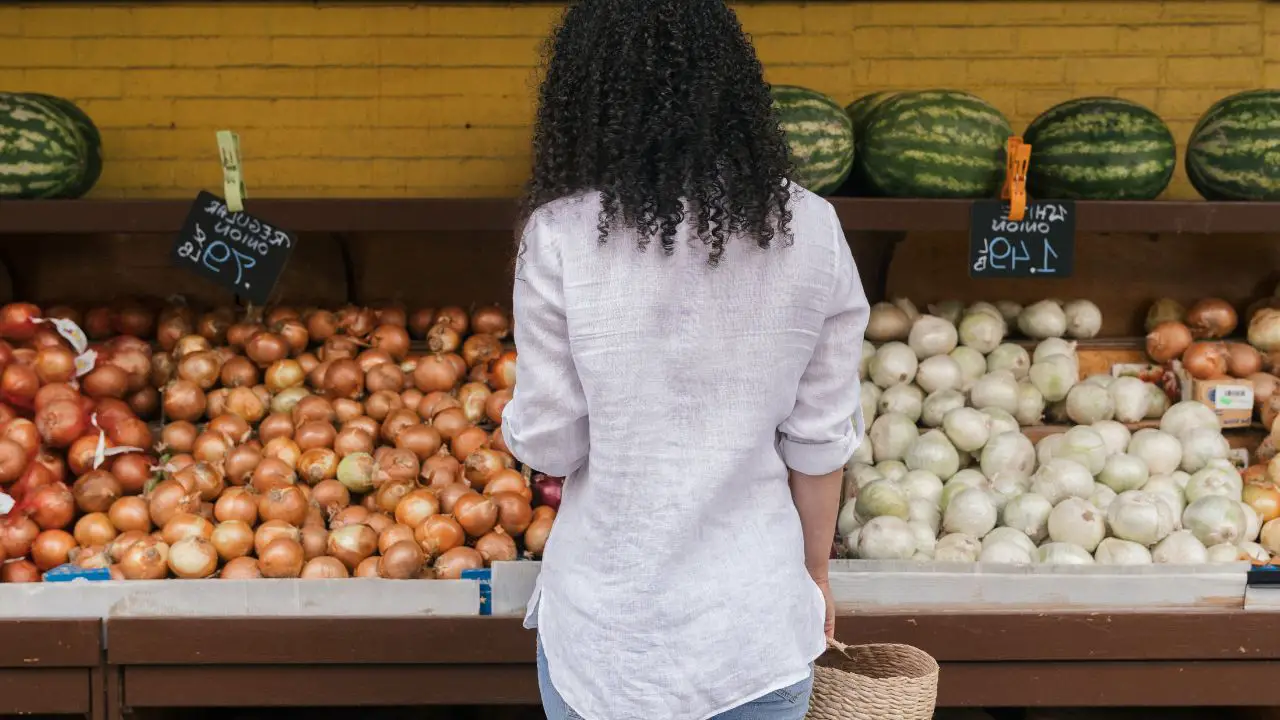Picking onions at the grocery store can be a tricky task. There are many different types of onions, and each has its own unique color, flavor, and texture.
Most supermarkets like Walmart carry at least six different varieties; Fairway sells about a dozen; and, depending on the time of year, Greenmarkets may have even more.
So, how do you know which onion to choose for your dish?

Here is an easy guide with some helpful tips on how to pick onions at the grocery store so you can get the best ones for your taste and your recipe.
1. Yellow Onion
Yellow onions, also called brown onions, are considered all-purpose but are best for cooking.
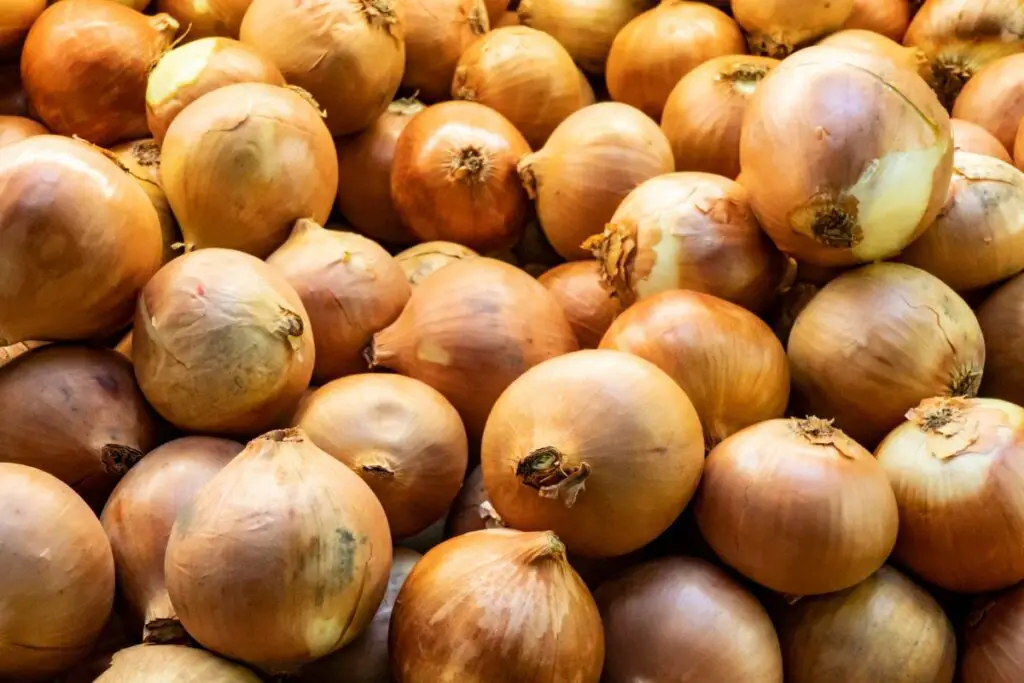
When an ingredient is listed in a recipe as just “onion,” yellow onion is the best choice for cooking. These layered bulbs have yellow skin and a strong flavor due to their high sulfur content. However, this strong flavor mellows out during sauteing or cooking and becomes flavourful and sweet.
So if you’re looking for an onion that will add some delicious flavor to your meal, yellow onions are probably the option.
While the yellow onion is an excellent addition to many cooked dishes, its strong flavor can be overwhelming in salads. Those sensitive to raw onion’s taste and smell may want to avoid using it in salads or opt for a different type of onion that I will cover below.
For those who can handle the strong flavor, however, yellow onion can add an excellent depth of flavor to salads. Just be sure to use it sparingly!
How to select and store:
A yellow onion’s outer skin is yellowish-brown and often a little bit thicker than the skin of the white onion and is both papery and rough.
Pick yellow onions that are firm, heavy for their size, and free of bruising.
Avoid yellow onions that have started sprouting.
Storage
Store whole yellow onions in a cool, dry environment with the peel still on.
Although they are often sold in plastic bags, ideally, you should not store them in a plastic bag since they require airflow to stay fresh longer.
When stored in a large bowl in a cool, dry place, whole yellow onions will last for 4-6 weeks. To extend their shelf life even further, you can store them in the fridge.
Pre-cut yellow onions should be kept in the refrigerator in an airtight container.
2. White Onions
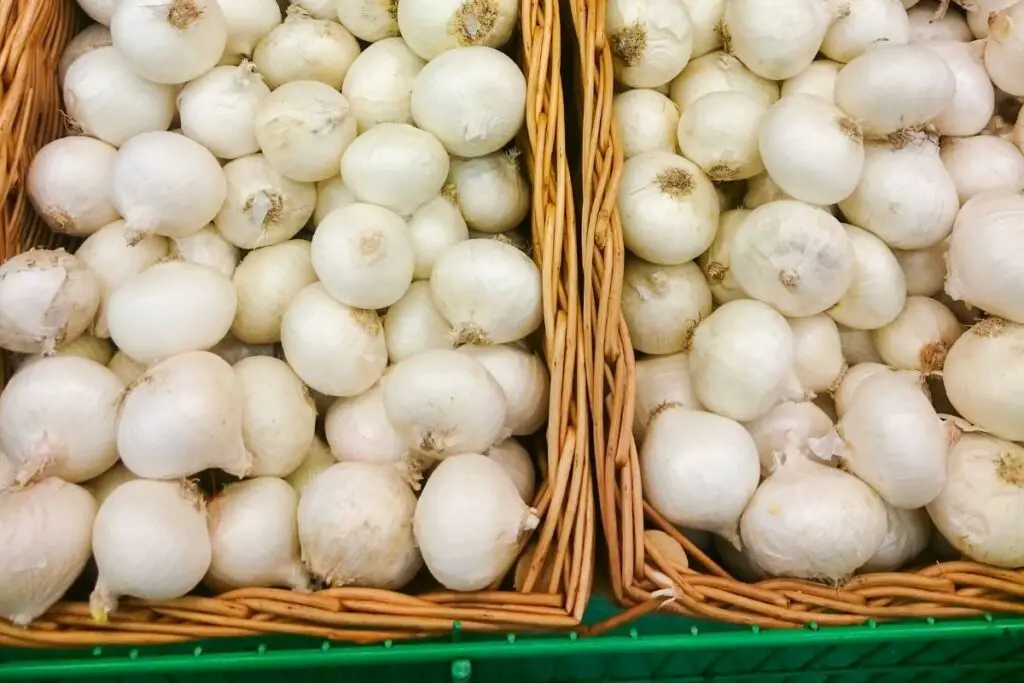
White onions are another great choice for cooking. Compared to their yellow counterparts, white onions are even stronger and more intense in flavor than yellow ones.
Although they are sharp, the sharpness is balanced with a hint of sweetness. The sweetness of white onions increases during cooking.
But I must admit that I prefer yellow ones for cooking over white ones because white onions tend to break down and fall apart too much when cooking. If the texture is not important in your recipe, then absolutely, you can go for white ones.
How to select and store:
You can recognize the white onions in your supermarket by tender and thinner, more papery white skin.
There are a few things to remember when choosing the best white onion.
- First, look for firm onions with the smooth, dry outer skin. Avoid the ones that are soft or have any brown spots.
- Second, smell the onion before you buy it. You should be able to smell a faint onion aroma; if you can’t, it is probably too old. However, if it has a rotten smell, it is gone bad.
- Finally, give the onion a gentle squeeze. The onion should be firm but not hard.
- Also, avoid white onions that have started sprouting.
Storage
To store white onions, place them in a cool, dry location with good ventilation. Onions can be stored in a variety of containers, including paper bags, mesh bags, or storage bins.
Be sure to keep onions away from other produce, as they can cause other fruits and vegetables to spoil more quickly and vice versa.
Check on them regularly, and remove any that show signs of mold or rot. When stored in a cool, dry place, whole, raw white onions will last two to three months.
3. Sweet Onions
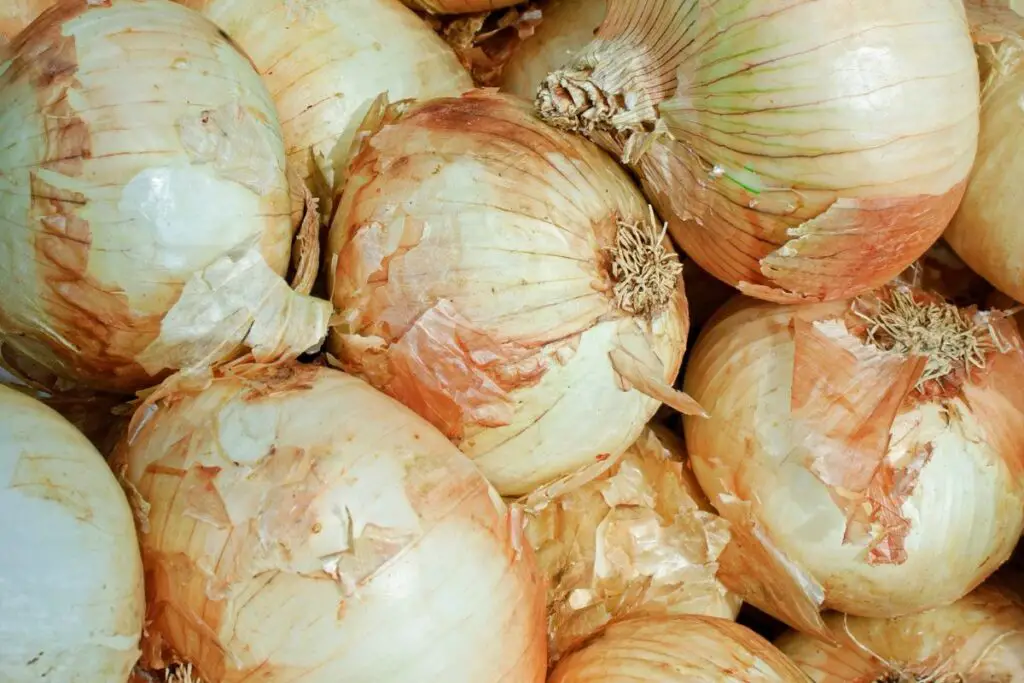
As you can guess— sweet onions are sweet! They don’t have the strong, sharp flavor of white or yellow onions. The most popular sweet onions you can find in most grocery stores are Vidalia and Walla Walla varieties.
Sweet onions are great for caramelizing because of their high sugar content. This makes them ideal for dishes with onion as a primary flavor, like onion soup or caramelized onion pizza, and so on.
The sweetness of the onions also helps to balance out the other flavors in the dish.
Their large size and delicious sweeter flavor make them a popular choice for onion rings.
Also great in relishes, raw salads, and chopped as a garnish.
How to select and store:
Sweet onions are typically larger and slightly flatter than yellow onions, with lighter colored, less opaque skins.
When choosing sweet onions at the supermarket, it is important to consider a few factors.
- First, look at the onion and ensure it is free of blemishes.
- Second, smell the onion – it should have a sweet fragrance.
- Finally, give the onion a gentle squeeze – it should be firm to the touch.
- Avoid the ones that have started sprouting.
Storage
To store sweet onions, place them in a cool, dry, and well-ventilated area. However, to keep them fresh longer, sweet onions should be stored and wrapped individually in a paper towel or a paper bag in the refrigerator.
Be sure to check on the onions periodically and use them within 2-3 weeks for the best flavor within 2 months if refrigerated.
Some sweet onion types are only available at a specific time of the year because they can only be cultivated in particular places.
4. Red Onions
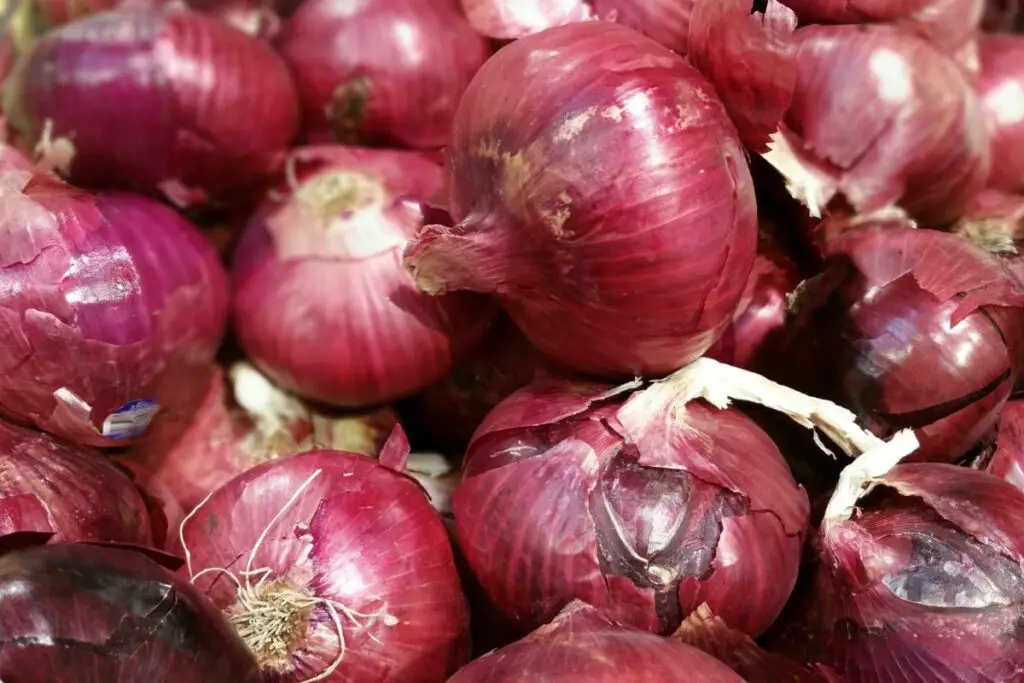
Red onions have a bit of a zing, but their flavor is milder than their white or yellow counterparts. Cooking makes them softer and sweeter; however, some of their reddish-purple color is lost.
Red onions are a very versatile ingredient and a great addition to a variety of dishes. They add flavor and depth to soups, stews, and sauces. They can also be roasted or grilled, which brings out their sweetness. When used in salads, they add a nice crunch and a pop of color.
How to Select and Store:
Red onions are easily distinguished by their red or purple skin.
Pick red onions that are firm, heavy for their size, and free from bruising. Keep their skin on and store in a cool, dry, and dark place.
Storage
Red onions will easily last 30 or even 60 days if stored in the fridge and two to four weeks if left on the kitchen counter.
Pre-cut red onions should be kept in the refrigerator in an airtight container.
5. Green Onions
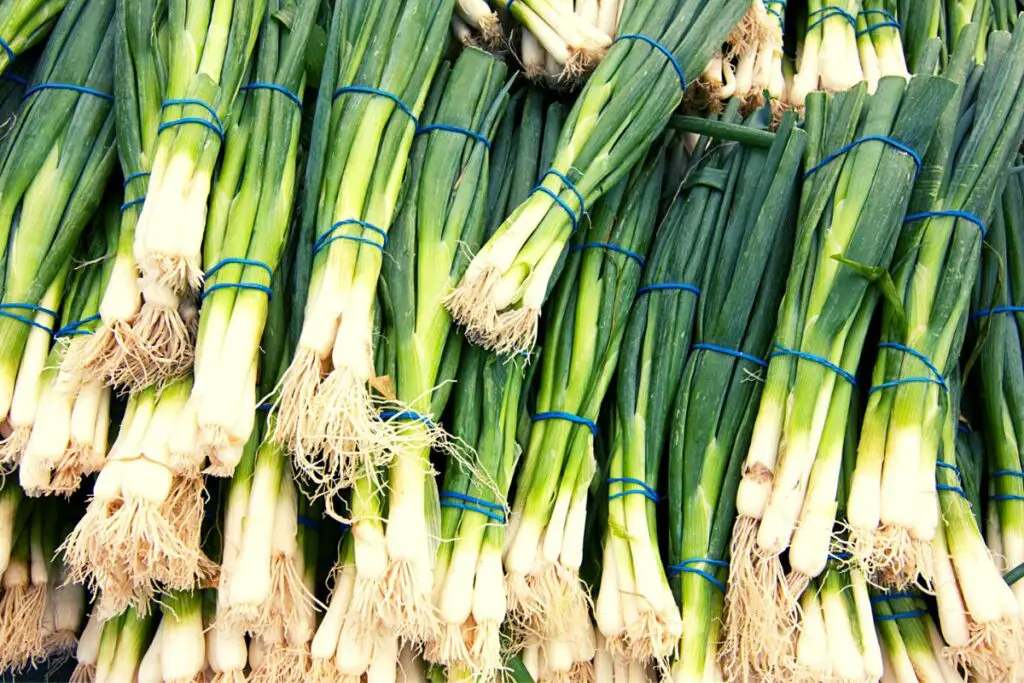
Scallions are a variation of young green onions, also called spring onions.
Green onions are a type of onion that is harvested before the bulb has fully formed. The entire onion, including the green stalks, is used in cooking. Green onions have a milder flavor than mature onions and are often used as a garnish or in salads.
In terms of flavor, scallions have a light, peppery, somewhat-spicy flavor characteristic of onions. However, unlike red or white onions, scallions are not as strong in taste and have a more subtle flavor.
Additionally, scallions have a crunchy texture and slightly sweet taste that is reminiscent of shallots.
Scallions can be eaten in their entirety, although the white end is more pungent. They can be cooked or served raw; however, the longer they are cooked, the more flavor they will lose.
Scallions are great to top off soup; use them in stir-fry, add to salad, tuck them into sandwiches, turn them into scallion pancakes, use them as a garnish, and much more.
How to select and store:
Green onions should have a sturdy, bright white root with small roots still attached and vibrant, green, fresh stalks that can easily stand upright. Avoid buying green onions that are starting to wilt, have spots, or have a slimy, black film on them.
Storage
Green onions should be kept in the refrigerator’s crisper drawer. Avoid storing green onions in plastic bags as they require airflow to stay fresh.
You can also keep green onions root side down in a shallow glass of water on your countertop. This will cause multiple re-growths of the green tips. Change the water every day to keep the scallions fresh.
6. Pearl Onions
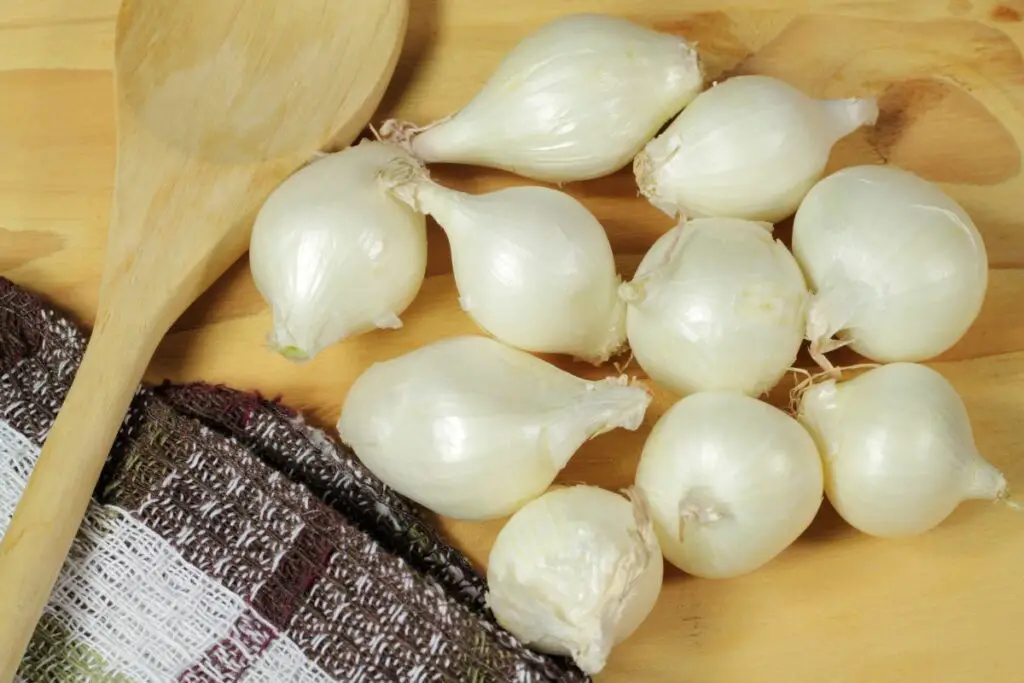
A pearl onion, also known as a button, silverskin, or baby onion, is a small onion that is about the size of a marble. They are white or pale yellow in color and have a milder flavor than other onions.
Pearl onions are often used in cooking because they add flavor to dishes without being overpowering, but they are a versatile addition to many dishes. and can be incorporated fresh into salads.
Their sweetness pairs well with savory flavors, and their small size makes them easy to incorporate into various recipes without the need for cutting or chopping.
Pearl onions can be used in soups, beef stews, stir-fries, casseroles, and even roasted or grilled dishes. As with other onions, when cooked, their flavor mellows and becomes more nuanced, making it a versatile ingredient that can enhance the flavor of many different dishes.
Pearl Onions are also great when creamed or pickled.
How to select and store:
As their name suggests, pearl onions are tiny, roughly the size of a large marble. Instead of being sold separately, they are usually sold combined in bags or containers.
Depending upon the specific variety, they come in several colors, including white, golden yellow, and red. The white type is the most common, followed by red and gold. The color of the onion is not an indicator of flavor or quality.
Look for pearl onions with a papery outer peel that is firm, unbruised, and free of blemishes.
Storage
Pearl onions can be stored for up to a month in a cool and dry place. They should be stored in a well-ventilated area such as a pantry, root cellar, or garage. Keep them in a mesh bag or a perforated plastic bag to allow air circulation.
Check on them periodically to make sure they are not sprouting or drying out. To use, trim the root end and peel away the skin.
7. Shallots
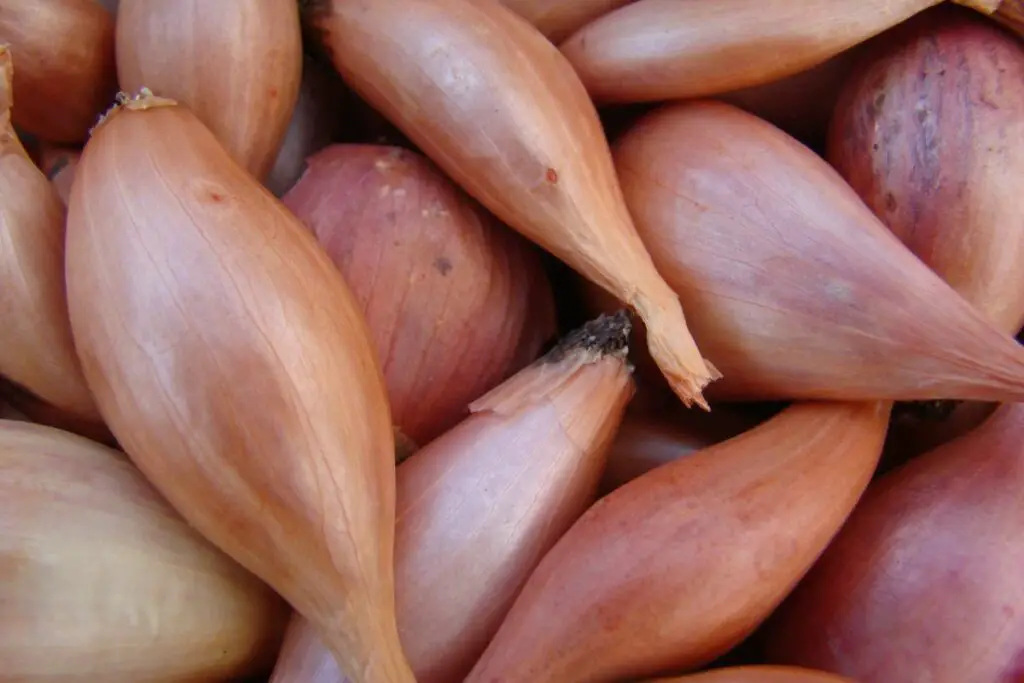
Although not technically an onion, shallots (Allium ascalonicum) are found alongside onions and garlic in supermarkets and grocery stores. Shallots grow in clusters like garlic and are a member of the allium family, which is closely related to onions.
Shallots have a milder, sweet, and delicate flavor than onions and are often used as a substitute for onions in recipes; and are delicate enough to eat raw and preferred choice for potato salad. They are often preferred by French chefs since they don’t have that strong tangy bite that onions do.
How to select and store:
You can recognize shallots in your grocery sore by the following distinction:
- 1. Shallots look like small yellow onions.
- 2. Their skin is papery deep golden brown, sometimes reddish or even coppery.
- 3. Their flesh is white and pale purple.
- 4. Their bulbs are sold separately or in clusters.
When selecting shallots at the supermarket, look for bulbs that are firm to the touch and free of blemishes. Avoid shallots that are soft or have brown spots, as these may indicate rot. Picking shallots that are smaller in size will often result in a sweeter taste.
Storage
Whole raw shallots will last for one to two months in a cool, dark place. Store them in a paper bag or in a loose-fitting mesh bag to allow for circulation.
Check on them periodically to make sure they are not sprouting or rotting. When they start to sprout or show signs of rot, use them immediately or discard them.
How To Tell If An Onion Is Bad?
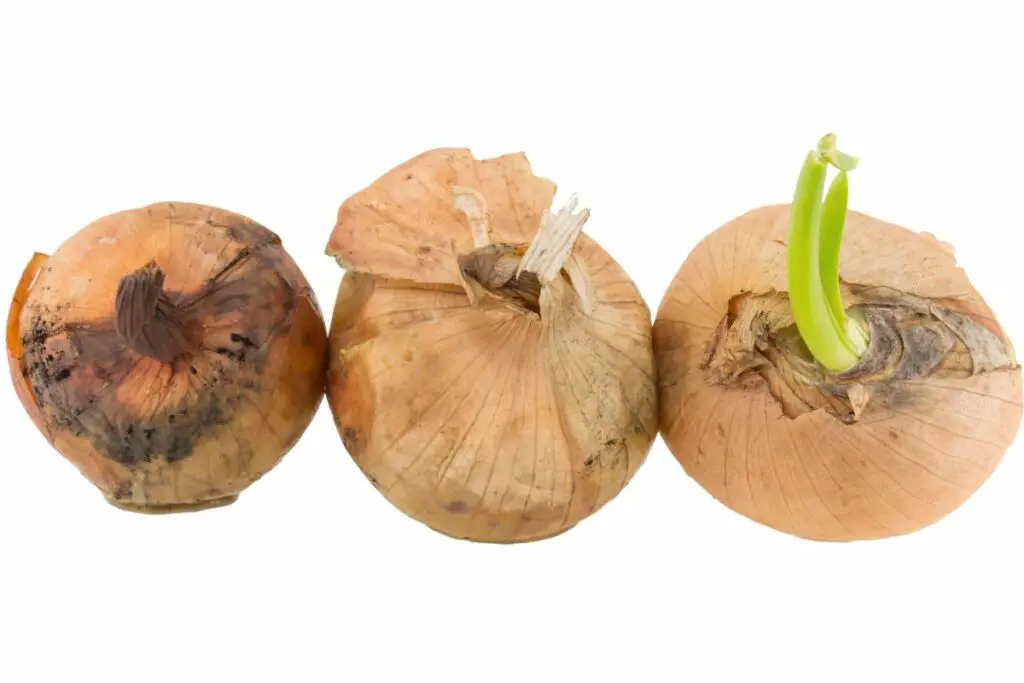
If you’re not sure whether an onion has gone bad, there are a few telltale signs to look out for. You simply need to trust your senses to accomplish this.
Here’s what you need to look out for:
Smell The Onion
If you notice that your onion has started to emit a foul odor, the onion has likely gone bad. Onions are prone to rotting if not stored correctly, so if you notice that your onions have a rancid or rotting scent, it is best to throw them away.
Visual Inspection
A good, fresh onion should be solid and free of brown and black spots. Spots typically result from injuries to the flesh of the bulb.
There should also be no mold or rot present. Just keep in mind that a darker exterior does not always indicate poor quality.
If the onion has started sprouting, you can still eat it, but you should use it as soon as possible. What bigger the sprouts grow, the onion will rapidly lose its taste and texture and gets mushy and unpalatable.
Touch The Bulb
A good onion should have a firm texture, not a mushy or slimy texture. This is because the firmness of the onion indicates its freshness, while a mushy texture indicates that the onion is beginning to rot.
Additionally, a slimy texture often indicates that the onion has been in contact with moisture for too long, which can also lead to rotting.
Read Also: How To Get Rid Of Garlic And Onion Breath And Body Odor (11 Smell Busters).
Summing Up
So, how to pick onions at the grocery store? There are a few things to remember.
- First, these layered bulbs come in wide different varieties, so it is important to choose the right one for your taste and for your recipe.
- Second, they should be firm and free of blemishes.
- Third, they should be free of any green sprouts, except scallions.
- Finally, Once you cut an onion, wrap the leftover half in plastic wrap, and store it in the refrigerator for up to 3 days.
